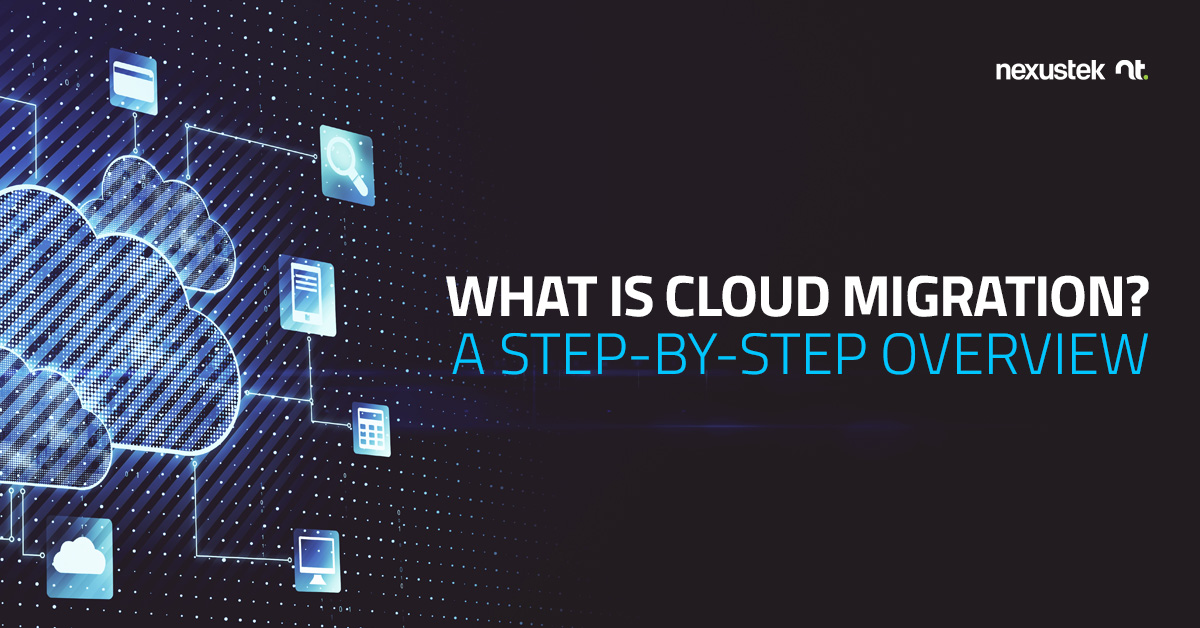READ TIME: 4 MIN

What Is Cloud Migration? A Step-By-Step Overview
Although many small and medium-sized businesses (SMBs) are now running at least a small portion of their workloads in the cloud, 63% still rely heavily on internal servers1. Migrating to the cloud, which involves moving your IT resources from on-premises infrastructure to one or more cloud-based environments, has become increasingly attractive because it helps to future-proof your IT and can reduce total cost of ownership by 30-40%2.
But, to obtain such desirable outcomes, you need to understand how the migration process works and how it can go wrong. Following is a high-level overview of the cloud migration process.
Discover Applications and Servers:
To start, you need to have a full accounting of your IT resources.
- This includes your on-premises resources as well as anything currently running in the cloud.
- Be careful to take account of any shadow IT, which are applications that may have been added without your IT team’s knowledge or involvement.
- Determine which applications are business-critical, which you wish to access remotely, and which you would prefer to keep on-premises.
Weigh Your Cloud Options & Assess Connectivity:
The cloud is not a single environment. There are multiple cloud providers who offer a variety of cloud types and services. You also need to take connectivity into account.
- Are you interested in public cloud, private, or a combination of the two? Do you want to keep some of your workloads on-premises or move fully to the cloud?
- Most SMBs choose a multi-cloud or hybrid cloud structure, which allows you to run different applications in different settings based on best fit. A multi-cloud approach can also allow you to get the best price value for different applications.
- You’ll need to determine your preferred distribution of management of infrastructure elements. Do you want the cloud provider to manage the entire infrastructure, from servers to data and applications? Or would you prefer to manage elements like data and applications in-house and have the cloud provider manage the rest of the infrastructure? Your choice will likely depend on the expertise of your in-house IT team and level of staffing.
- Keep in mind that your internet connection will need to be sufficient to handle the increased bandwidth of accessing data and applications hosted in the cloud. Given the number of users and the requirements of the applications they will be accessing, make sure that your internet speed is fast enough to handle the new demands.
Analyze Configuration & Dependencies:
This is a step where many SMBs struggle. In fact, understanding application dependencies was the #1 challenge for SMBs in migrating to the cloud, reported by 57% of technology decision makers3.
- To plan a migration effectively, you need to understand the relationships between applications, infrastructure, and operations. This is because the functionality of applications may depend upon specific relationships that may not be present or possible in the new cloud environment.
- If this step is overlooked or not completed properly, applications may not function normally once migrated to the cloud, and in the worst cases, they may not function at all. This is a time-consuming and costly error.
Evaluate Compatibility Issues:
This is another area that can be challenging for SMBs to manage; 43% reported hitting stumbling blocks related to compatibility issues during migration4.
- It is important to recognize that your destination cloud environment may use different operating systems and APIs than your on-premises environment.
- Similar to issues of fit related to app dependencies, compatibility problems can create performance issues or even application failure in the new cloud environment.
Decide Which Applications to Migrate:
Once you have taken stock of your current environment and its attributes, you can begin making decisions about your future environment.
- For applications that will not be successful using a “lift and shift” approach—meaning, they cannot be migrated to the cloud as-is—you will need to decide whether to leave those applications on-premises or modify them so that they will work in the new cloud environment.
- Some legacy applications may not have a SaaS equivalent and may require refactoring or even rewriting the code to run successfully in the new cloud environment.
- Whether it makes sense to invest in refactoring or rewriting will vary from one business to the next; many businesses choose to keep such applications on-premises while moving other applications to the cloud, adopting a hybrid cloud model.
Consider Compliance Needs:
If your business operates within an industry that carries additional data privacy and security regulations, this is another important consideration when planning migration.
- If some or all of your data is subject to regulations like HIPAA, GDPR, or FINRA, it is important to choose a compliant cloud provider.
- Make sure that a new cloud provider understands your regulations and is willing to complete any required documentation to support your compliance.
Formulate Security Strategy & Policy:
Moving to the cloud requires that you establish new security practices and policies.
- With your data now in a remote location and accessible from a variety of endpoints located in diffuse settings (e.g., as with remote work), it is important to establish a zero-trust security protocol with a layered security regimen that protects all areas of vulnerability.
- If you will allow employees to use their own devices (i.e., BYOD) or work from home, it is important to have security policies in place that stipulate cyber safe behavior.
Plan Migration Roadmap:
A careful, step-by-step roadmap is required to make sure that all applications and data are moved successfully while safeguarding against data loss and disruption of your business operations. Completing data backups is an essential step, as is testing the new systems to make sure all data transferred to the cloud successfully and all applications run as needed.
NexusTek offers cloud readiness assessments to help you through each step of your migration, along with IT spend assessment to help you determine the most cost-effective infrastructure choices. Whether you need a second set of eyes or full support with your cloud migration project, our expert engineers are here to help.
References:
- (2021, June 25). Research: SMB IT stack decisions based on fulfilling business needs. https://www.techrepublic.com/resource-library/research/research-smb-it-stack-decisions-based-on-fulfilling-business-needs/
- (2021, August 25). Small business cloud adoption in 2021. https://www.impactmybiz.com/blog/infographic-small-business-cloud-adoption/
- (2022). State of cloud report. https://resources.flexera.com/web/pdf/Flexera-State-of-the-Cloud-Report-2022.pdf?elqTrackId=f3bb660986704d2980404386aa003141&elqaid=6925&elqat=2
- (2021). The definitive guide to migrating to the cloud. https://www.vmware.com/learn/396671_REG.html?src=WWW_us_MKT_n3U2aSwVcTXZxbqIMsFd&int_cid=7012H000001lFP0






